
The longest-living cruiser of South America
Chacabuco was a 1890s British-designed protected cruiser by Philip Watts at Elswick in 1897, and a sister shp to the Japanese Takasago. She was modernized during WW2 and had a fairly long career until 1952. In fact she was still around in 1959, pending her fate.
Context: The Argentine-Chilean naval arms race
The Argentine–Chilean naval arms race, was initiated by the Chileans in 1887, acquiring the battleship Capitán Prat, and the protected cruisers Presidente Errázuriz and Presidente Pinto. In the return Argentina ordered the Libertad and Independencia, and later the Veinticinco de Mayo and Nueve de Julio.
Chile naturally could not rest idle, and 1892 ordered in UK one of the most formidable cruiser at the time, Blanco Encalada. In 1895, not to be undone, Argentina ordered ARA Buenos Aires, to what the Chilean answered with another, even more massive cruiser, the Esmeralda, and later Ministro Zenteno.
⚙ The naval Arms Race | |
 Armada de Argentina Armada de Argentina |  Armada de Chile Armada de Chile |
| Libertad class (BB) 1887 Veinticinco de Mayo (PC) 1890 Nueve de Julio (PC) 1891 Buenos Aires (PC) 1894 Garibaldi (AC) 1895 San Martín (AC) 1896 Pueyrredón (AC) 1897 General Belgrano (AC) 1898 Rivadavia, Moreno* (AC) 1901 |
Capitán Prat (BB*) 1887 Presidente Errázuriz (PC) 1887 Presidente Pinto (PC) 1887 Blanco Encalada (PC) 1892 Esmeralda (AC) 1894 Ministro Zenteno (PC) 1894 O'Higgins (AC) 1896 Constitución class (BB) 1901 Chacabuco (PC) 1901 |
Next Argentina went with four armored cruisers built in Italy, Garibaldi class. To what Chile replicated in 1896 with O’Higgins and in 1901, with two further orders confirmed, Chile, ordered two battleships, which turned out to be the second-class Swiftsure class Constitución and Libertad.
In the same move, they also ordered the protected cruiser Chacabuco. Eventually as Argentina was also to order two battleships, Great Britain came to the rescue and force a treaty between those nations. The strain on Chile has been enormous in particular, as its started o commit, like a gambler, its gold reserve to pay for new acquisitions. Eventually due to the tight links between UK and Chile, which was highly dependent for some deliveries, did not want to risk the country’s future economy and this resulted also in the cancellation of the two pre-dreadnoughts, which were taken over by the RN to combat the Russians in the far east. The treaty whi peut and end to the rivalry was signed on 28 May 1902
Her sister ship IJN Takasago at Portsmouth
At the end of this however, Chacabuco was completed as a sister-ship of the IJN Takasago, an export class cruiser of Sir Philip Whatt’s Elswick cruiser of 1896. Same design, with a balanced armament with two main 8-in guns and a serie of 4.7 in secondaries.
She was launched on 4 July 1898 and was far too close to completion for cancellation at the signing of the agreement between Chile and Argentina, so she was completed and acquired in 1902, just before the treaty was applied.
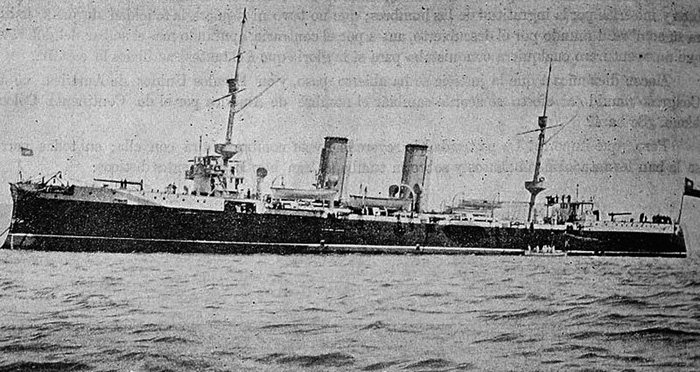
Chacabuco on 15 October 1902
Name:
Chacabuco was named originally, and provisionally Fourth of July, was actually a battle in Feb. 12, 1817, securing José de San Martín’s south patriots a decisive success against Spanish Royalists north of Santiago, Chile. It mostly secured the Independence of Chile, also after a campaign by José Miguel and Juan José Carrera on the one hand, and Bernardo O’Higgins on the other. The latter became rightfully so an important warship name as well in the Chilean Navy.
Design of the Chacabuco
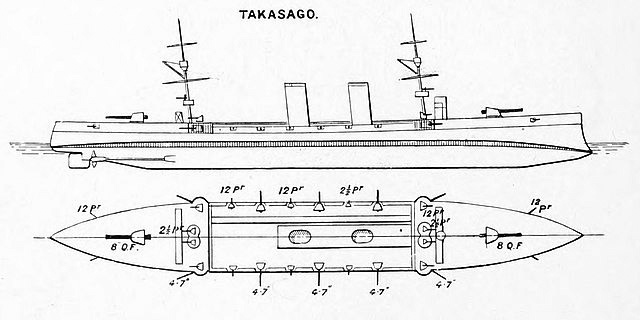
Her sister ship Takasago on Brasseys
Hull & main characteristics
Classic Watt’s design at Armstrong Whitworth with a forecastle and poop, main guns on these decks, and secondary guns at battery deck below, some on sponsons and under well design protective masks, just as the main guns. Forward bridge above the conning tower, military mast fore and aft with fighting tops and spotting platforms, two funnels heavenly spaced and small platform aft for redunncy plus quarterhouse. Both masts had limited rig for optional sails, never mounted. Projectors were also mounted either side of the main bridge platform wings.
She carried small boats along the amidship flying bridge, along the funnels and eight air grates, vents and ducts. There was a single steam pinnace, a picket boat, two dingheys, two yawls. It could have been possible to have the 3-pounder guns dismounted and carried on board to cover landing parties, but no wheeled mount was provided for them. The anchors were three, fitted on sloped plates forward of the forecastle deck, one port and two starboard.
Chacabuco entered service with the typical Victorian livery of 1898, black hull, upper deck white and superstructures in “sand canvas” (masts, funnels, bridges). The main guns shields were whote, as the gun shields. She had a golden-looking armories at the prow like most war vessels of the time. This was changed in overall white, and supestructure partly in dark grey in 1907-1908. Probably at the time of WW2, she had an overall medium grey livery, and still was painted that way after refit in WW2 and until the end of her career.
Armor protection of the Chacabuco
It matched the caliber of her main guns, and concrned the belt, the armored deck, and some details of her battery decks and gun shields:
- Main waterline belt: 4.5-in (114 mm) sloped
- Armored deck: 1.75-4.5-in (44-114 mm)
- Conning Tower: 3-in (76mm)
- Gun shields: 4.5 in (114 mm)
Armament
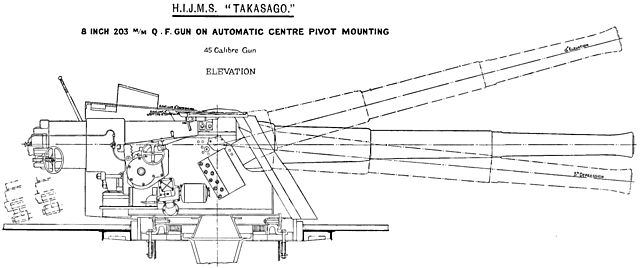
Elswick 8-in guns and pivot, showing its elevation
2x 8-in/45 Elswick
The EOC 8 inch 45 caliber designed in 1894 and operational in 1895. These were Pattern S guns on a single pedestal mount and enveloping shield. It fired a separate loading bagged charge and 116 kg (256 lb) projectile at a rate of fire of 2 rpm and muzzle velocity of 790 m/s (2,600 ft/s) and max firing range of 18 km (11 mi) at 30°.
10x 4.7-in/40 Elswick
Designed from 1885, this ordance uses a separate loading QF AP or HE 45 pounds (20.41 kg) shell to a – 20° elevation, 5–6 rounds per minute at 1,786 feet per second (544 m/s), max range 10,000 yards (9,100 m) at 20°. All shielded, they were located along the battery deck (five, including two in niches and recesses in the forecastle).
12x 12-pdr vickers
The 1893 QF 12-pounder 12 cwt naval gun uses a single-motion screw breech, for 15 rpm at 2,210 ft/s (670 m/s) and 11,750 yd (10,740 m) range at 40° elevation. There four four along the battery deck either side (8 in all), alternating the 4.7 in guns with simple flat shields and taller mounts. The last four were installed under the bridge’s wings fore and aft and in hull’s recesses fore and aft.
6x 3-pdr Hotchkiss
1885 standard QF gun firing a fixed QF 47 × 376 mm R 3 kg (6.6 lb) shell with charge, 1.5 kg (3.3 lb) alone 47 mm (1.9 in) projectile at 30 rpm, 571 m/s (1,870 ft/s) and max 5.9 km (3.7 mi) at +20°.
8x 0.303 Maxim LMG
Singe mounts, difficult to locate and only stated by a few sources. Not Conways for example.
3x 18-in TTs
Standard Whitehead model, above waterline, presumably two broadside, one at the bow which is visible on photos. One reload for each.
Later in 1941 six 6-in/40 guns were installed. If prewar vintage, they had the following specs: 6.6 tons with a barrel length of 240 inches (6.096 m), firing a 100 pounds (45 kg) QF, separate cartridge and shell at 5-7 rounds per minute and 2,154 feet per second (657 m/s). It could elevate to 20° and its max range is 10,000 yards (9,140 m).
Powerplant
It was rather standard with power two shafts driven by two vertical triple-expansion steam engines fed by the steam coming from six cylindrical boilers, rated for a total of 15,700 ihp (11,700 kW) and a designed speed of 23 knots (43 km/h; 26 mph).
Specifications of Chacabuco (1898) |
|
| Dimensions | 109.7 m oa x 14.2 m x 5.2 m (360 x 46 x 17 ft) |
| Displacement | 4,160 long tons (4,230 ST) FL |
| Crew | 400 |
| Propulsion | Two shaft VTE, 6 cyl. boilers, 15.700 ihp |
| Speed | 23 knots (43 km/h; 26 mph) |
| Range | Unknown |
| Armament | 2x 8-in/40 (8-in), 10x 4.7 in/40, 12x 3-in, 6x 3 Pdr, 3 TTs. |
| Armor | Armored deck 1.75-4.5 in, gun shields 4.5 in, CT 3 in |
A (very) long service history
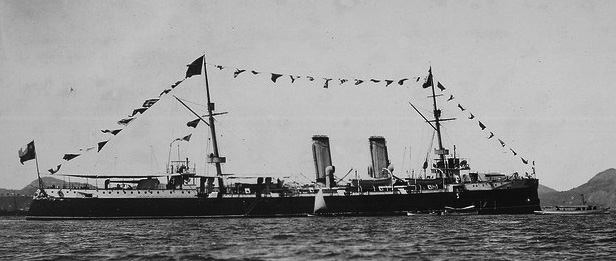
Chacabuco in 1898, just completed.
In the middle of 1902 it sailed from Portmouth under the command of the ship’s captain Pedro Nolasco Martínez. It was part of a flotilla also made up of destroyers O’Brien, Thomson and Merino Jarpa. During her journey to Chile, she stopped in Cherbourg and participated in the national holidays of France (14 of July 1902).
Chacabuco arrived in Valparaíso by October 1902 in Chile, and started routine patrols, later interrupted by hydrographic duties in Chilean waters. In 1903, on a courtesy trip, she visited Buenos Aires, Montevideo and Bahía Blanca. She was fitted to carry out hydrographic surveys in the area between Antofagasta and Coquimbo.
After the 1906 Valparaíso earthquake she came there to assist the overwhelmes security services, helping maintaining order, preventing damage on property and pillage; She used her artillery to destroy some buildings, her crew helping to remove debris and controlling acts of looting.
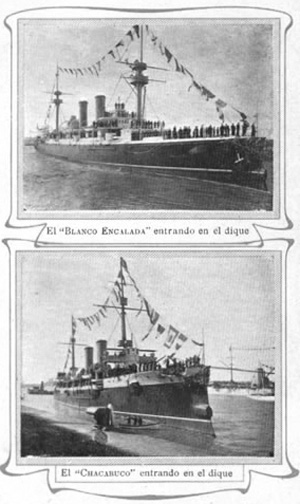 She also took a role of assistance in the Santa María School massacre in 1907. From 1907 to 1911 he was part of the National Squad. She was present in 1911 in the British Royal Navy fleet review, held in honor of the coronation of King George V.
She also took a role of assistance in the Santa María School massacre in 1907. From 1907 to 1911 he was part of the National Squad. She was present in 1911 in the British Royal Navy fleet review, held in honor of the coronation of King George V.
In 1914-18 Chile remained neutral, and she kept a watchful eye on south Atlantic possible German attack on neutral or Chilean trade fleet. The British escorted the vessels well in order to keep importing what Chile had to offer. When the battle of Coronel happened, Chacabuco was far away.
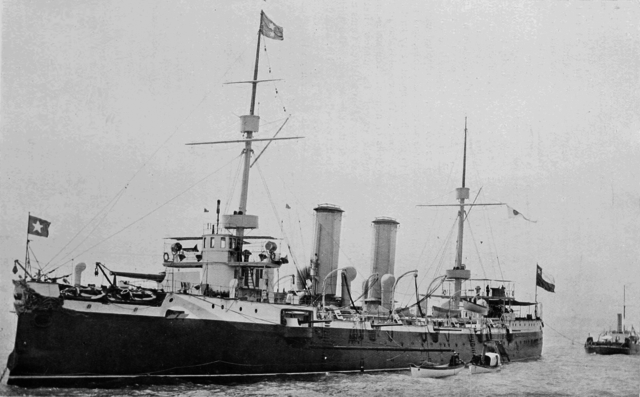
In 1917, she sailed to support the transport SS Casma which ran aground in the Picton channel. She carried out later an hydrographic mission, a survey of the Picton Pass, updating maps.
Also in 1917, Great Britain ceded to Chile in compensation for the seizure of the battleship Valparaíso, six Holland-class submarines built in the United States. Chacabuco moved to New London in Connecticut to escort them to Chile.
While she cruised back home, she troured several cities, stopping in Charleston, Havana, Kingston, Arica before reaching Valparaíso. On board, she also brought three million dollars in gold bullion, as payment for the sale of saltpeter to the United States.
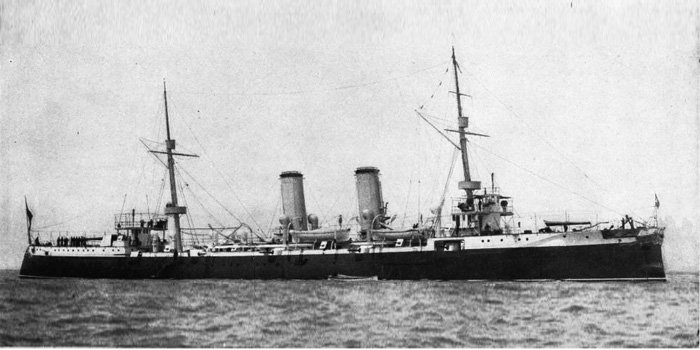
Cacabuco in 1900
Chacabuco made another relief effort, this time during the November 10, 1922 Vallenar earthquake, between Atacama and Coquimbo.
As part of the National Squad until the end of 1928, passing in Talcahuano to the reserve until 1941.
Due to her age, she was placed in reserve in 1928. The admiralty wanted to use her as training ship, possibly with a conversion in order to be rearmed with modern ordnance, and partial reconstruction and accomodations. Discussion went nowhere as the economical situation of Chile prevented new acquisitions.
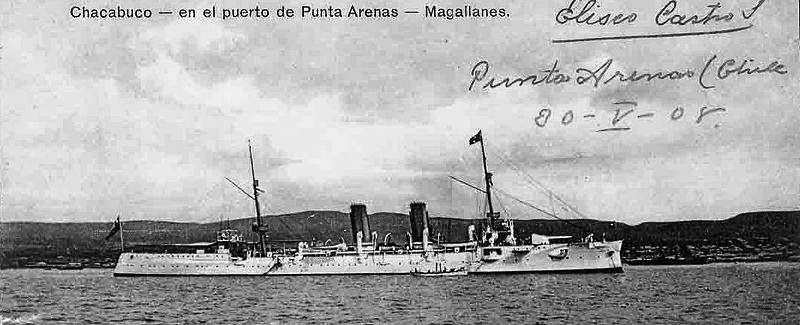
Chacabuco in Punta Arenas, circa 1920
Chacabuco’s second life: 1942-50
In 1941, amazingly, Chacabuco was still held in reserve, in a degraded state. As a vessel of the 1890s she was completely obsolete. This time again Chile maintained its neutrality, but feared that encounters with German U-Boats would led to a declaration of war. As the only cruiser available, Chacabuco was brought out of reserve and the admiralty conducted a survey for a possible reconstruction.
By then there were no other cruisers available in the Chilean Navy and was too precious to be converted as a training ship. Instead, she was fully modernized to the latest standards. Her hull was modified, her armament was changed to six more modern 6 inch/50 guns and a revised AA with Hotchkiss 57 mm guns.

Profile of Chacabuco as modernized in WW2.
In 1941, her modernization was carried out, consisting of changing its main armament for 6 6”/50 cannons and the installation of extra anti-aircraft machine guns. Deflectors were installed in the funnels and she was provided with anti-submarine equipment and paravanes to search for mines. The command bridge was enlarged, and her habitability was improved in order to be used as a training ship, with new accomodations.
At this time, her armament comprised still her two 203mm/45 main guns, under better shields, ten 120mm/40 and twelve 76mm/40 AA plus six 47mm/40 guns and three 450mm TT. But six 152mm/50 EOC tirpedo tubes were added, as well as four single 57mm/40 Hotchkiss AA guns. In 1945, this was altered to four 57mm/40 and ten 20mm/70 Mk 4 Oerlikon AA guns.
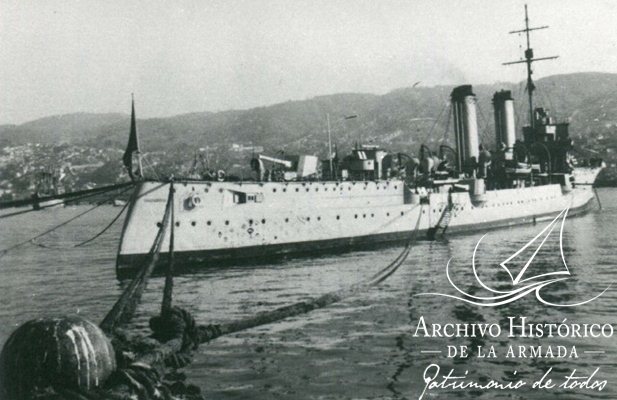
Chacabuco at anchor in Valparaíso, after her modernization concluded in 1942. This involved the modernization of the bridge, renovation of boilers, new funnels, removal of the mizzen mast and main 8 inches guns, as well as four secondary pieces 4.7 inches. Of the latter, six were left. Later in 1945, ten 20mm anti-aircraft pieces were installed. Original photograph of the time. Source: Martin Skalweit Herter Collection src.
In 1942, she joined the Squadron and carried out drilling work between Caldera and Valparaíso, rectified some notable points in Coquimbo and carried out the survey of the port of Punta Arenas.
In 1943 she quelled the Papudo uprising. In 1944 she was based in Matanzas cove. In 1945, she carried out the survey of the Herradura de Guayacán cove and Punta Tortuga. In January 1946, her crew was sent to control a coal miners’ strikes. During all these years and until 1947, in addition to the aforementioned hydrographic works, she was part of the National Squadron, as flagship on various occasions.
Chacabuco became flagship alternating with battleship Almirante Latorre, and after the war, was modified to assume the peacetime role of midshipmen school cruiser, with new accomodations, a role that she held only from from 1949 to 1950, making for a 50 years career.
In December 1950, after carrying out three training cruises within the national coastline she called the Talcahuano port, where she was definitively placed out of commission.
Chacabuco was put in reserve again for almost ten years, only stricken from the lists on 15 December 1959. She was by then sold to the Compañía de Acero del Pacífico (Pacific Steel Company) for scrapping.
Read More/Src
Conway’s all the world’s fighting ships 1906-21 and 1922-47.
web.archive.org – from armada.cl
Garrett, James L. “The Beagle Channel Dispute: Confrontation and Negotiation in the Southern Cone”.
Sater, William F. “The Abortive Kronstadt: The Chilean Naval Mutiny of 1931”.
Scheina, Robert L. Latin America: A Naval History 1810–1987.6.
Somervell, Philip. “Naval Affairs in Chilean Politics, 1910–1932”.
Worth, Richard. Fleets of World War II. Cambridge, MA: Da Capo Press, 2001.
Museo Naval y Marítimo – Valparaíso, Armada Chile. ed. Cruceros de instrucción 1936-1954
On armada.cl
Chacabuco 1898 wikipedia es
armada.cl archive
Book: Historia de la Marina de Chile, Carlos López Urrutia

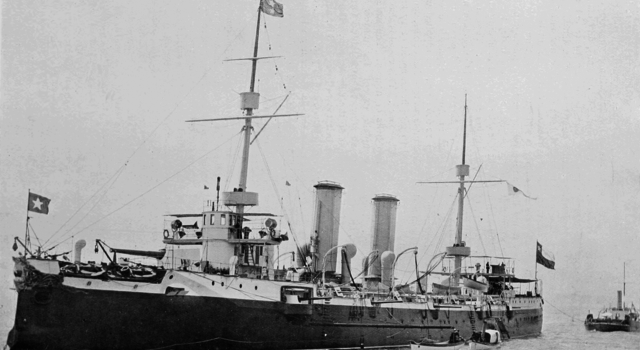

 Latest Facebook Entry -
Latest Facebook Entry -  X(Tweeter) Naval Encyclopedia's deck archive
X(Tweeter) Naval Encyclopedia's deck archive Instagram (@navalencyc)
Instagram (@navalencyc)





 French Navy
French Navy Royal Navy
Royal Navy Russian Navy
Russian Navy Armada Espanola
Armada Espanola Austrian Navy
Austrian Navy K.u.K. Kriegsmarine
K.u.K. Kriegsmarine Dansk Marine
Dansk Marine Nautiko Hellenon
Nautiko Hellenon Koninklije Marine 1870
Koninklije Marine 1870 Marinha do Brasil
Marinha do Brasil Osmanlı Donanması
Osmanlı Donanması Marina Do Peru
Marina Do Peru Marinha do Portugal
Marinha do Portugal Regia Marina 1870
Regia Marina 1870 Nihhon Kaigun 1870
Nihhon Kaigun 1870 Preußische Marine 1870
Preußische Marine 1870 Russkiy Flot 1870
Russkiy Flot 1870 Svenska marinen
Svenska marinen Søværnet
Søværnet Union Navy
Union Navy Confederate Navy
Confederate Navy Armada de Argentina
Armada de Argentina Imperial Chinese Navy
Imperial Chinese Navy Marinha do Portugal
Marinha do Portugal Mexico
Mexico Kaiserliche Marine
Kaiserliche Marine 1898 US Navy
1898 US Navy Sovietskiy Flot
Sovietskiy Flot Royal Canadian Navy
Royal Canadian Navy Royal Australian Navy
Royal Australian Navy RNZN Fleet
RNZN Fleet Chinese Navy 1937
Chinese Navy 1937 Kriegsmarine
Kriegsmarine Chilean Navy
Chilean Navy Danish Navy
Danish Navy Finnish Navy
Finnish Navy Hellenic Navy
Hellenic Navy Polish Navy
Polish Navy Romanian Navy
Romanian Navy Turkish Navy
Turkish Navy Royal Yugoslav Navy
Royal Yugoslav Navy Royal Thai Navy
Royal Thai Navy Minor Navies
Minor Navies Albania
Albania Austria
Austria Belgium
Belgium Columbia
Columbia Costa Rica
Costa Rica Cuba
Cuba Czechoslovakia
Czechoslovakia Dominican Republic
Dominican Republic Haiti
Haiti Hungary
Hungary Honduras
Honduras Estonia
Estonia Iceland
Iceland Eire
Eire Equador
Equador Iran
Iran Iraq
Iraq Latvia
Latvia Liberia
Liberia Lithuania
Lithuania Mandchukuo
Mandchukuo Morocco
Morocco Nicaragua
Nicaragua Persia
Persia San Salvador
San Salvador Sarawak
Sarawak Uruguay
Uruguay Venezuela
Venezuela Zanzibar
Zanzibar Warsaw Pact Navies
Warsaw Pact Navies Bulgaria
Bulgaria Hungary
Hungary

 Bundesmarine
Bundesmarine Dutch Navy
Dutch Navy Hellenic Navy
Hellenic Navy Marina Militare
Marina Militare Yugoslav Navy
Yugoslav Navy Chinese Navy
Chinese Navy Indian Navy
Indian Navy Indonesian Navy
Indonesian Navy JMSDF
JMSDF North Korean Navy
North Korean Navy Pakistani Navy
Pakistani Navy Philippines Navy
Philippines Navy ROKN
ROKN Rep. of Singapore Navy
Rep. of Singapore Navy Taiwanese Navy
Taiwanese Navy IDF Navy
IDF Navy Saudi Navy
Saudi Navy Royal New Zealand Navy
Royal New Zealand Navy Egyptian Navy
Egyptian Navy South African Navy
South African Navy






























 Ukrainian Navy
Ukrainian Navy dbodesign
dbodesign